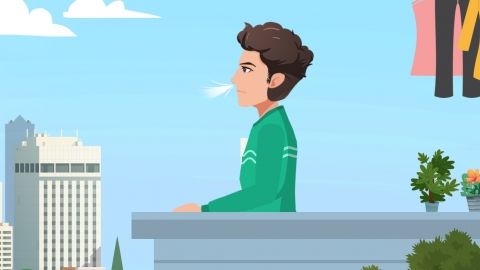Why does deep breathing cause chest discomfort?
Generally, the causes of chest discomfort triggered by deep breathing include muscle spasms, hyperventilation, pleurisy, costochondritis, pneumothorax, etc. The solution depends on the specific cause and prompt medical attention is required, following medical advice for treatment. Details are as follows:

1. Muscle Spasm: In some cases, deep breathing may cause excessive or sudden contraction of the respiratory muscles, leading to muscle spasms and resulting in chest discomfort or pain. Usually, no specific treatment is required, and symptoms may resolve spontaneously after a period of rest.
2. Hyperventilation: Hyperventilation refers to rapid and deep breathing within a short period, causing excessive exhalation of carbon dioxide, thereby reducing blood CO₂ levels and triggering respiratory alkalosis, which may result in chest discomfort, numbness of hands, dizziness, and other symptoms. Patients should stop hyperventilating and adjust breathing rate and depth by adopting diaphragmatic breathing or slow deep breathing techniques.
3. Pleurisy: Pleurisy is an inflammatory condition of the pleura, usually caused by infection, autoimmune diseases, trauma, or other factors. During deep breathing, chest pain or discomfort may occur due to stretching or irritation of the pleura, often accompanied by coughing. Anti-inflammatory and anti-tuberculosis medications such as Penicillin V Potassium Tablets, Aspirin Tablets, Rifampin Tablets should be used according to medical advice.
4. Costochondritis: Costochondritis is a non-specific inflammation of the costal cartilage, possibly related to strain, trauma, or viral infection. Pain or discomfort occurs during deep breathing due to stretching or compression of the costal cartilage, and the pain may radiate to the back or abdomen. Anti-inflammatory medications such as Celecoxib Capsules, Diclofenac Sodium Sustained-Release Tablets, Etoricoxib Tablets should be used under medical guidance.
5. Pneumothorax: Pneumothorax refers to the entry of gas into the pleural cavity, causing increased intrapleural pressure and compressing lung tissue, which results in symptoms such as dyspnea and chest pain. During deep breathing, the increased intrapleural pressure may exacerbate chest pain and dyspnea, and may also be accompanied by a dry cough. A closed thoracic drainage procedure should be performed according to medical instructions to remove gas from the pleural cavity and reduce intrapleural pressure.
During treatment, it is important to follow medical instructions, take medications regularly, and adjust lifestyle and dietary habits to promote recovery.
References:
[1] Ge Junbo, Xu Yongjian, Wang Chen. Internal Medicine [M]. 9th edition. Beijing: People's Medical Publishing House, 2018.
[2] Lin Guowei, Wang Jiyao, Ge Junbo. Practical Internal Medicine [M]. 15th edition. Beijing: People's Medical Publishing House, 2017.




